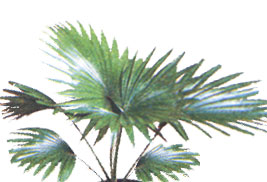Palm tree
Refers to the family of palm trees. Fatherland - South Asia, Australia. New Guinea, Polynesia.
General description: Liviston is a fan palm. She hastily grows and is quite unpretentious.
Usually in the room conditions the following species are bred:
Livistona australis (Livivona southerly). A tall palm tree, in the nature reaches 25 m. The thickened trunk is covered with closely adhering remains of old leaves. Large leaves (wai) are split into segments (there are more than 50 of them), but not to the very base. Leaves of leaves are covered with sharp spines. This palm tree is sprawling, it will need a lot of room.
Livistona chinensis (Livivona Chinese). Its fan leaves are distinguished by the fact that the tips of the segments in it are drooping.
Recommendations for the care of the plant Palm Liviston:
Illumination : photophilous, requires direct sunlight.
Watering mode : Watering is forced to be even. Abundant during the growth period, the winter is mild.
Humidity : Requires regular spraying and washing under the shower.
For summer it is better to place on a fresh atmosphere (in a park or on a balcony), in a room protected from wind.
Temperature regime : In summer it is mild, in winter it is cool 14-16 ° C, at least 8 ° C.
Soil : Proper benign drainage is required. You can add small gravel or expanded clay.
Recommended soil mishmash: 2 elements of light clayey-sod, 2 elements humus-leaf, 1 share of peat, 1 proportion of overgrown manure and 1 share of sand.
During the growth period, it needs fertilizing once a week with complex fertilizers for ornamental-deciduous plants. Nutrients are consumed quickly.
Breeding : In the end of winter seeds are sown. Use soil heating.
Transplantation : Transplanted in the spring, at what time the pot is made tight (the roots begin to germinate through the drainage holes), once every few years. When transplanting large specimens, perform partial trimming of the roots.
Pests : Affected by a spider mite (in a dry atmosphere, leaves and stems are braided with cobwebs), scabbards (brown plaques appear on the leaves and stems, leaving sticky excretions), mealy worms (covered with snow-white cotton wool).
The plant is allowed to help finish with a soap solution, warm washing and spraying with an actinic (1-2 ml per liter of water).

Palm of livistone - livistona


Comments
When commenting on, remember that the content and tone of your message can hurt the feelings of real people, show respect and tolerance to your interlocutors even if you do not share their opinion, your behavior in the conditions of freedom of expression and anonymity provided by the Internet, changes Not only virtual, but also the real world. All comments are hidden from the index, spam is controlled.